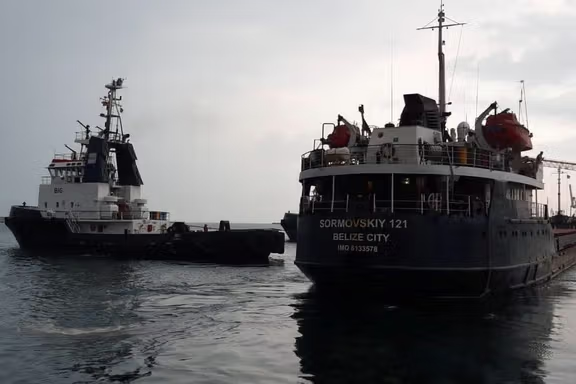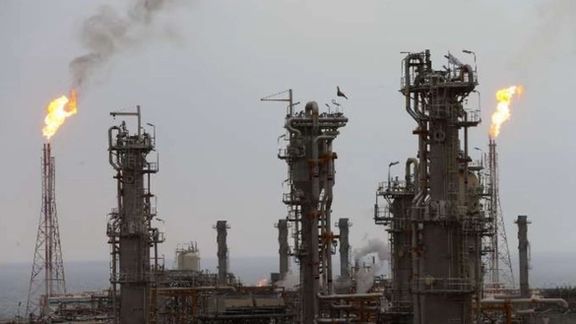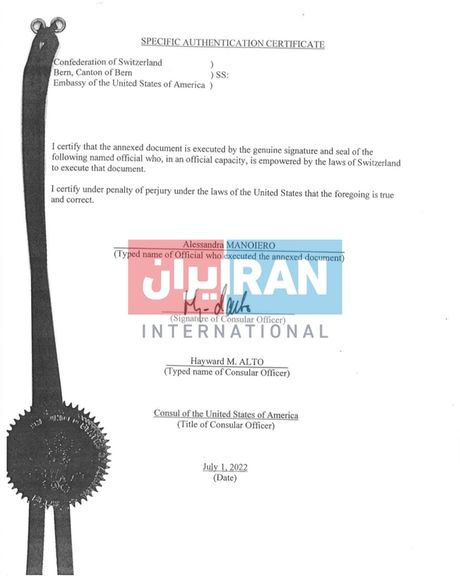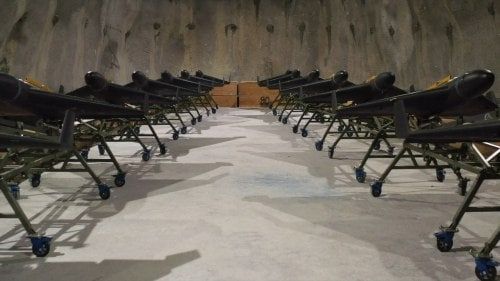Ukraine Ships Corn To Iran As Tehran Plans Sending Drones To Russia

A ship carrying 60,000 tons of corn has left a Ukrainian Black Sea port to deliver the first batch of the much-needed food to Iran since the Russian invasion of Ukraine.

A ship carrying 60,000 tons of corn has left a Ukrainian Black Sea port to deliver the first batch of the much-needed food to Iran since the Russian invasion of Ukraine.
The Marshall Island-flagged Star Laura departed from the port of Pivdennyi on Friday, along with the Belize-flagged Sormovsky that left Ukraine's Chornomorsk port laden with 3,050 tons of wheat bound for Turkey's northwestern Tekirdag province.
While Ukraine has restarted its food exports to Iran, the Islamic Republic is said to have plans to export drones to Russia to be used during the war. The US Thursday that Russian officials have undergone training in Iran in recent weeks as part of an agreement on the transfer of drones from the Islamic Republic.
A total of 14 ships – most loaded with grain for animal feed or for fuel -- have now departed from Ukraine over the past two weeks, following the UN-brokered deal with Russia in Turkey to allow a resumption of grain exports from three Ukrainian Black Sea ports, after they were stalled for five months due to the war.
As part of the UN deal, all ships are inspected in Istanbul by the Joint Coordination Centre, where Russia, Ukrainian, Turkish and UN personnel work.
Ukraine has some 20 million tons of grain left over from last year's crop, while this year's wheat harvest is also estimated at 20 million tons. Ukraine and Russia accounted for nearly a third of global wheat exports and nearly a fifth of corn before February 24, when Russia launched its invasion.

Iran's deputy oil minister says negotiations for Russian natural gas imports are in their final stages as Iran faces falling output in the Persian Gulf.
Mohsen Khojasteh-Mehr, who also serves as the head of National Iranian Oil Company (NIOC), told Fars news agency that converting the memoranda of understanding (MoUs), sealed between NIOC and Russian Gazprom cover various fields, including petroleum and gas swaps.
Iran and Russia in July agreed to $40 billion in trade and investment projects.
A swap means that Iran would import gas from Russia and deliver a certain quantity to another country that has a gas purchase deal with Moscow if it makes sense geographically or in terms of available infrastructure. In this case, among Iran’s neighbors only Turkey has a gas deal with Russia, but it has its own pipelines, much shorter in distance than a 2,000-kilometer longer route from Iran.
Buying Russian gas to cover shortages
This makes the Iranian claim of a gas swap strange. What appears to be more likely is Iran buying Russian gas to cover its own production shortages.
Russia, in turn, which has been buying gas from Central Asian countries as a middleman and exporting it, has a shrinking market after sanctions following its invasion of Ukraine. Existing pipelines that send the cheap gas from Central Asia to Russia can now be reversed and pump it to Iran.
Last year, Russia imported 10.5 billion cubic meters (bcm) of Turkmen and 4.6 bcm of Kazakh gas through these pipelines, according to BP statistics.
There are also two pipelines, connecting Turkmenistan to Iran's northeastern regions with 20 bcm/yr capacity together. Currently Turkmenistan delivers only 1.5 bcm/yr of its gas via these routes.
Fars news agency says Iran can import 20 bcm/yr of Russian gas for both domestic consumption and delivery to Iraq and Turkey.

It seems the first variant is feasible, because Iran had 250 mcm/d gas deficit last winter (equal to Turkey's total daily gas demand in 2021) and every year the gap between its gas production and demand is growing.
Fars says Iran has consumed 9 billion liters of diesel and 6 billion liters of mazut in electricity generation last year, due to gas shortage. Iran can consume Russian gas in power plants to be able to export more diesel and mazut, making more profit, if the Russian gas is below regional prices.
Russia helping Iran in gas production?
Fars reported that another important MoU between NIOC and Gazprom is related to pressure enhancement of South Pars gas field in the Persian Gulf, shared between Iran and Qatar.
In the absence of Western technology, Iran has been unable to keep up production at the field, steadily losing out as its domestic consumption has increased.
Fars said if the sides finalize the MoU and sign an agreement, the contract value would be $10bn.
According to the NIOC, the Iranian section of South Pars gas field would pass the half-mark point of its life by 2023 and every year its production would decline 10 bcm. Iran and a consortium headed by French Total signed a $5-bn contract in 2016 to develop the South Pars, including the installation of a 20,000-ton platform with two giant compressors to prevent production decline.
Iran needs at least 10 to 15 such giant platforms (15 times bigger than the current active platforms) in South Pars. Each new platform costs $2.5 billion.
It is not clear how Gazprom would enhance the pressure of the gas field as only large Western energy companies can build the giant platforms with huge compressors.
When Total left the South Pars contract due to US sanctions, Chinese CNPC also abandoned the project due to its inability to build larger platforms. Gazprom also has no experience or the technology for such a project in the sea.
Qatar installed huge platforms, through contracts with Western companies, especially Total, and not only prevented a decline in production, but it has started new drillings to increase gas output by 30% in the next five years.
Regarding Iran's inability to prevent production decline from South Pars - a field that accounts for 70% of Iran's total gas output- it seems the country eyes Russian imports to compensate for the decline in South Pars and prevent further gas shortages in cold seasons.

Iran’s intelligence apparatus has cooperated with Turkey to kill an Iranian-born senior leader of the Kurdistan Free Life Party (PJAK) which seeks self-determination for Iran's Kurdish minority.
The so-called Amude-Derbesiye provincial leader of the PKK/YPG, Yusif Mehmud Rebani (Youssef Rabbani), code-named Rezan Cavit, was killed in a drone strike in the Syrian city of Qamishli by Turkey’s National Intelligence Organization (MIT) on August 6, Turkish media announced on Friday.
The drone struck his car and killed at least four other people, including Mazlum Esat, code-named Ruhaz Amude, and wounded two more.
"Commander Youssef Rabbani who was in Qamishil for a visit was confirmed dead in the attack," Hamrin Ali, the co-president of the local council of the Jazira region in the Kurdish-led Autonomous Administration of North and East Syria (AANES) said.
He joined the PKK in the 1990s, and in 2010 was part of the "Coordination Committee", the highest executive body of the Iranian branch of the organization, PJAK. MIT claimed he had also ordered the attacks against the Turkish armed forces during the period when the PKK was in charge of the Haftanin province.
Generally, the Kurdish parties in Iran − including Komala and the Kurdistan Democratic Party of Iran (KDPI) − favor Kurdish autonomy within a federal Iran. Pejak (the Free Life Party of Kurdistan), an affiliate of the Kurdistan Workers Party (PKK), formed in Turkey but also based in northern Iraq, has generally favored a unified, independent Kurdistan uniting Kurds in Syria, Iraq, Turkey, and Iran.

Switzerland has informed Tehran of a lawsuit filed against the Islamic Republic and IRGC in the US by families of victims of the Ukrainian plane shot down by Iran in 2020.
According to a document obtained by Iran International, the Swiss embassy in Tehran which represents US interests has officially informed the Iranian government of the lawsuit.
In June, Canada also announced that it has notified Iran of Ontario's Superior Court of Justice’s ruling that IRGC’s downing of Ukraine Airlines Flight PS752 was intentional.

In May 2021, some family members filed a civil lawsuit against Iran and senior officials they believe were to blame for the incident. Canada’s Ontario Court ruled that the downing of the plane was an intentional act of terrorism and on December 31, 2021, awarded compensation to be shared by the estates of the six victims.
In June, Canada's international human rights parliamentary subcommittee criticized the government's “passive” approach toward Iran’s widespread human rights abuses in a House of Commons subcommittee meeting attended by several political and human rights activists – including the spokesman of the Association of Victims' Families, Hamed Esmaeilion.
The airliner was shot down by two air-defense missiles fired by the IRGC on January 8, 2020, as it took off from Tehran’s Imam Khomeini International Airport. All 176 passengers and crew, including 63 Canadians and 10 from Sweden, as well as 82 Iranian citizens on the plane died in the disaster.

Flights by all Iranian airlines to Malaysia will completely stop as of Saturday, August 23, due to impact of sanctions on refueling Iranian planes.
Secretary of Iran's Aviation Companies Association Maghsoud Asadi-Samani told ILNA on Friday that the last Iranian flight to Kuala Lumpur will be operated by Mahan Airlines, which was the only airliner apart from flag carrier Iran Air with the capability of direct flights to Malaysia because of the long distance.
The Iranian company Mahan Air was sanctioned by the US in 2008 for links to the Quds (Qods) Force of Iran’s Revolutionary Guard.
Noting that Malaysian airports do not provide fuel to Iranian planes anymore, he said that fueling companies at Malaysian airports work with US companies, and these companies have been informed that they will be subject to punitive measures if they keep fueling the Islamic Republic’s planes.
Describing it as yet another blow that hit the country's aviation industry due to the US sanction, he said domestic airlines will lose the revenues of passenger transportation on this route, and “we will lose one of the bases in Southeast Asia.”
Before the Covid-19 pandemic hit the world, demand for this route was high, and two to three flights were made per week, but during the health crisis, flights to Malaysia were temporarily suspended, and after that, there was only one flight per week.

The US said Thursday that Russian officials have undergone training in Iran in recent weeks as part of an agreement on the transfer of drones from the Islamic Republic.
US State Department deputy spokesperson Vedant Patel reiterated during a phone briefing that Russian officials had conducted training on drones in Iran "in the last several weeks."
He said Washington would "vigorously enforce" its sanctions on both Russian and Iranian weapons trading as the transfers of drones between the two countries was "potentially sanctionable under numerous authorities," noting that "We remain incredibly concerned about Iran's use and proliferation of UAVs. They have been used to attack US forces, our partners in the region, and international shipping entities.”
Since last month, US officials have repeatedly said that Washington had information that Iran was preparing to provide Russia with up to several hundred drones, including some that are weapons capable, and that Russian officials had visited Iran to view attack-capable unmanned aerial vehicles (UAVs)
Iran has been supplying drones to its allies in the Middle East for a long time but selling drones to Russia to for its war in Ukraine has raised serious international concerns.
Iran's foreign minister denied the claim, including in a phone call with his Ukrainian counterpart but late In July, an Iranian lawmaker said the military cooperation between Tehran and Moscow has upset the political equations of the global order, confirming Russia’s request to buy Iranian drones.
US National Security Adviser Jake Sullivan warned twice in July that Moscow appears to be looking at buying Iranian drones and Russian officers even visited a drone base in Iran’s Kashan to review their options.
An adviser to President Volodymyr Zelensky told Iran International on July 25 that Russia and Iran are allies in the Ukraine war and it won’t be a surprise if Tehran supplies drones to Moscow.